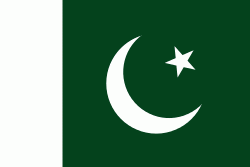Tharparkar (Thar Pārkar District)
Tharparkar (Dhatki/ٿرپارڪر, ), also known as Thar, is a district in Sindh province in Pakistan headquartered at Mithi. Before Indian independence it was known as the Thar and Parkar district.
The district is the largest in Sindh, and has the largest Hindu population in Pakistan. It has the lowest Human Development Index rating of all the districts in Sindh. Currently the Sindh government is planning to divide the Tharparkar district into Tharparkar and Chhachro district.
The name Tharparkar originates from a portmanteau of the words Thar (referring to the Thar Desert), and parkar (meaning "to cross over"). The Thar region was historically fertile, although it was mostly desertified between 2000 and 1500 BC. Before its desertification, a tributary of the Indus River was said to flow through the region; it is speculated by some historians that this river could be the ancient Sarasvati River mentioned in the Hindu Rigveda. The Thar region is also mentioned in the Ramayana, where it is called "Lavanasagara" (meaning "salt ocean").
Sindh was ruled by various dynasties after the fall of the Indus Valley civilisation. These dynasties included the Soomras ), the Sammas, the Arghuns, the Kalhoras, and the Talpurs. These rulers mainly focused on the central and western parts of Sindh while the eastern areas, including Tharparkar were largely disregarded. In 1843, as a part of the British conquest of large parts of the Indian subcontinent, Charles James Napier, the Commander-in-Chief of the Presidency Armies, defeated the Talpur dynasty and conquered Sindh. The conquered areas, including Tharparkar, were incorporated into the Cutch Agency and Hyderabad Collectorate. The government of British India divided Sindh into Collectorates, or districts, administered by British-appointed Zamindars.
Sindh was later made part of the Bombay Presidency of British India. In 1858, the entire area around Tharparkar became part of the Hyderabad Division, and in 1860 the region was renamed as Eastern Sindh Frontier, with its headquarters at Amarkot. In 1882, it was reorganized as the Thar and Parkar district, headed by a British Deputy Commissioner, with a political superintendent at Amarkot. In 1906, the district headquarters was moved from Amarkot to Mirpur Khas. On 31 October 1990 the district was divided into the Tharparkar and Mirpur Khas Districts. On 17 April 1993, Umerkot District was carved out of Tharparkar.
The district is the largest in Sindh, and has the largest Hindu population in Pakistan. It has the lowest Human Development Index rating of all the districts in Sindh. Currently the Sindh government is planning to divide the Tharparkar district into Tharparkar and Chhachro district.
The name Tharparkar originates from a portmanteau of the words Thar (referring to the Thar Desert), and parkar (meaning "to cross over"). The Thar region was historically fertile, although it was mostly desertified between 2000 and 1500 BC. Before its desertification, a tributary of the Indus River was said to flow through the region; it is speculated by some historians that this river could be the ancient Sarasvati River mentioned in the Hindu Rigveda. The Thar region is also mentioned in the Ramayana, where it is called "Lavanasagara" (meaning "salt ocean").
Sindh was ruled by various dynasties after the fall of the Indus Valley civilisation. These dynasties included the Soomras ), the Sammas, the Arghuns, the Kalhoras, and the Talpurs. These rulers mainly focused on the central and western parts of Sindh while the eastern areas, including Tharparkar were largely disregarded. In 1843, as a part of the British conquest of large parts of the Indian subcontinent, Charles James Napier, the Commander-in-Chief of the Presidency Armies, defeated the Talpur dynasty and conquered Sindh. The conquered areas, including Tharparkar, were incorporated into the Cutch Agency and Hyderabad Collectorate. The government of British India divided Sindh into Collectorates, or districts, administered by British-appointed Zamindars.
Sindh was later made part of the Bombay Presidency of British India. In 1858, the entire area around Tharparkar became part of the Hyderabad Division, and in 1860 the region was renamed as Eastern Sindh Frontier, with its headquarters at Amarkot. In 1882, it was reorganized as the Thar and Parkar district, headed by a British Deputy Commissioner, with a political superintendent at Amarkot. In 1906, the district headquarters was moved from Amarkot to Mirpur Khas. On 31 October 1990 the district was divided into the Tharparkar and Mirpur Khas Districts. On 17 April 1993, Umerkot District was carved out of Tharparkar.
Map - Tharparkar (Thar Pārkar District)
Map
Country - Pakistan
 |
 |
| Flag of Pakistan | |
Pakistan is the site of several ancient cultures, including the 8,500-year-old Neolithic site of Mehrgarh in Balochistan, the Indus Valley civilisation of the Bronze Age, the most extensive of the civilisations of the Afro-Eurasia, and the ancient Gandhara civilization. The region that comprises the modern state of Pakistan was the realm of multiple empires and dynasties, including the Achaemenid; briefly that of Alexander the Great; the Seleucid, the Maurya, the Kushan, the Gupta; the Umayyad Caliphate in its southern regions, the Hindu Shahis, the Ghaznavids, the Delhi Sultanate, the Mughals, the Durranis, the Omani Empire, the Sikh Empire, British East India Company rule, and most recently, the British Indian Empire from 1858 to 1947.
Currency / Language
| ISO | Currency | Symbol | Significant figures |
|---|---|---|---|
| PKR | Pakistani rupee | ₨ | 2 |
| ISO | Language |
|---|---|
| EN | English language |
| PA | Panjabi language |
| PS | Pashto language |
| SD | Sindhi language |
| UR | Urdu |















